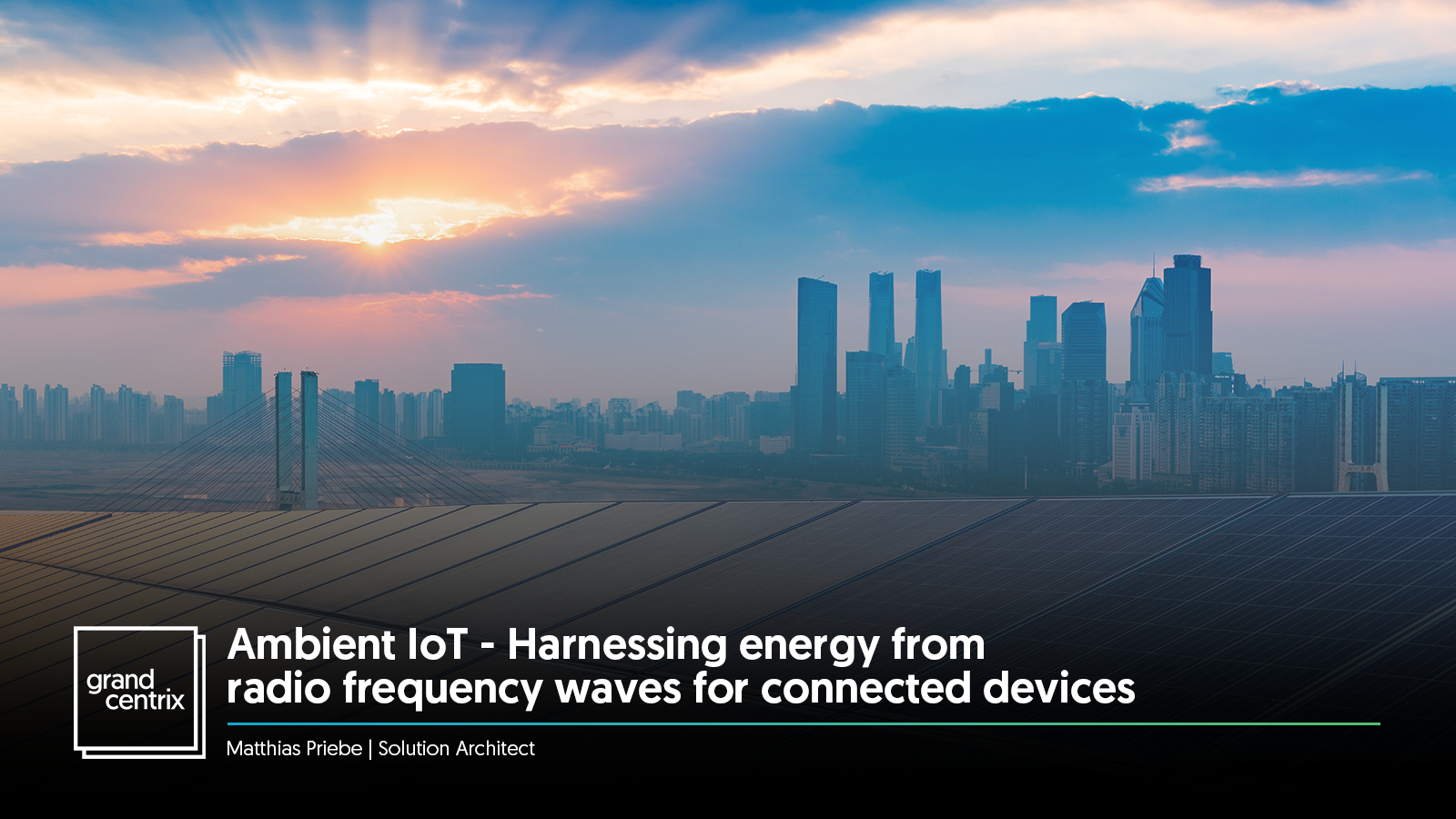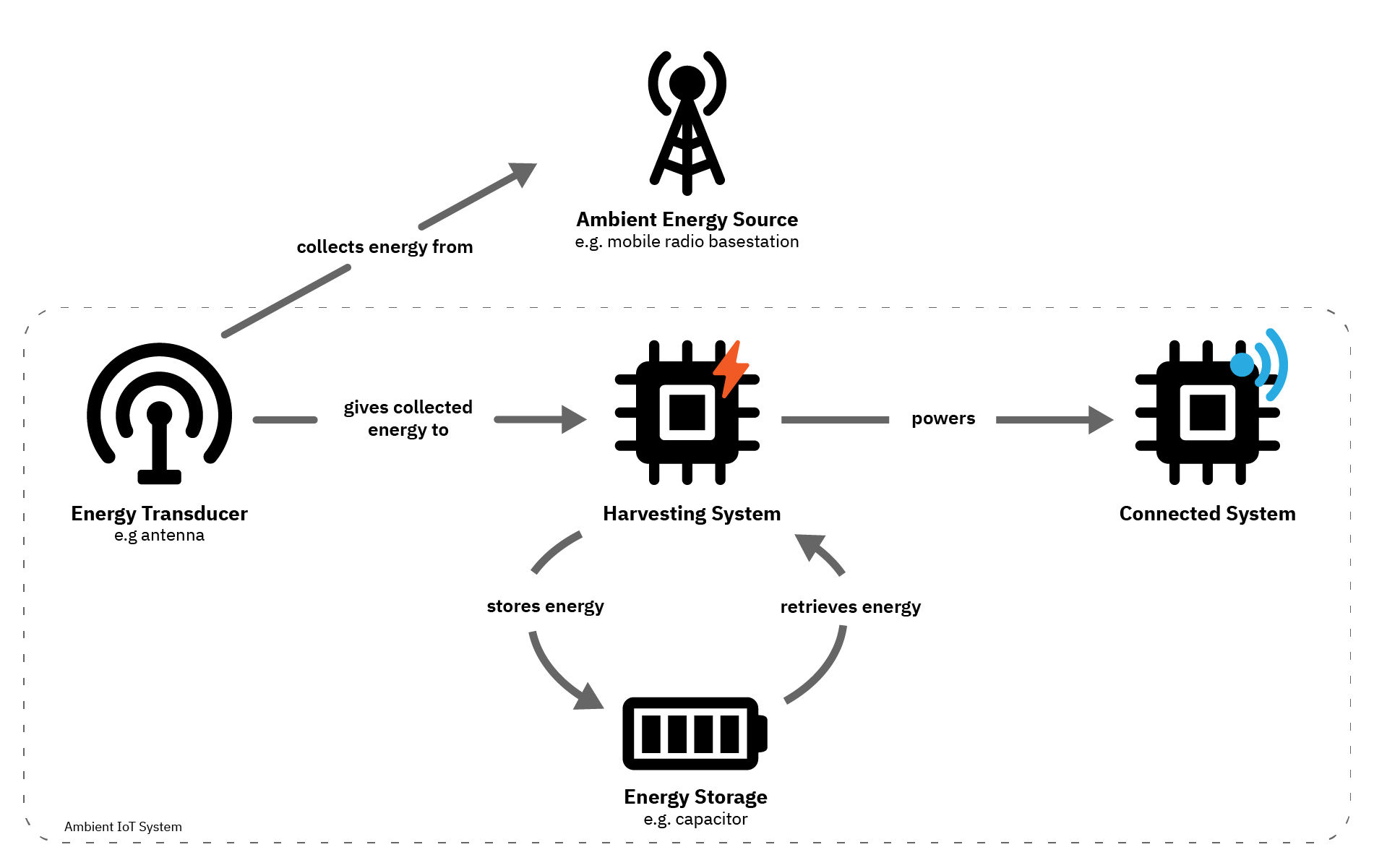
Imagine a world where your IoT devices could run indefinitely without the need to change batteries. This isn’t a distant dream, just a reality with Ambient IoT. At grandcentrix, we dedicate our work to make the Internet of Things (IoT) happen. However, IoT isn’t always a smooth ride and can sometimes give you serious headaches. Consider this scenario: You’ve meticulously developed a new IoT wireless sensor network. Every metric is visible in the cloud, ready for analysis. A wealth of data is available to business analysts. Processes that were once manual are now digital. Over the years, you’ve optimized your business, efficiency has grown, and so has profit. Everyone is happy.
Fast-forward three years after deployment. The first few sensors start to show battery lifetime warnings as they reach 20 % capacity. Anxiety builds up among the people maintaining the platform. What’s the next step? You have hundreds of sensors deployed, each equipped with small battery cells to keep the footprint and cost of the devices low. These devices have been deployed in several hard-to-reach regions, for example in tanks filled with liquids.
You start searching for solutions. Either a lot of people are just replacing the batteries, if the initial design made that possible, or worse, the whole device has to be swapped out because battery replacement wasn’t foreseen. Regardless of the solution, it will require a lot of effort and can weaken the business case of your IoT devices.
But what if there was a way to make it easier? As we care for our customers, we’re always thriving to explore new and exciting technologies to improve our products, our solutions and to further satisfy our customers. One aspect of making IoT happen is ensuring it is easy and accessible. Power Consumption is one of the factors that needs special attention when building IoT devices. As the example above shows, there are many decisions to be made during the design phase, each with its own pros and cons. But there’s one thing that’s gaining more and more attention in the IoT community which can simplify design around power management: Ambient IoT.
Harnessing Ambient Energy: The Path to Sustainable IoT Devices
Harnessing ambient energy for IoT devices can significantly enhance the battery life of these devices or, in the most optimal scenario, render them completely energy autonomous. We’ve already incorporated energy harvesting into our products. For instance, our Asset Tracker Solar utilizes a solar panel to prolong its operational duration.
However, solar energy is just one of the many sources that can be harnessed. Other potential sources include kinetic energy, thermal gradients, and an omnipresent source: radio frequencies.
Looking ahead, the two major standardization bodies in this field, the 3rd Generation Partnership Project (3GPP) and the Institute of Electrical and Electronics Engineers (IEEE), are both developing new standards for the use of ambient energy in IoT devices. These upcoming standards are set to revolutionize the industry and pave the way for more efficient and sustainable IoT devices.
Standardization and Potential Applications of Ambient Energy Harvesting in IoT
Standardization processes typically begin with use cases, primarily derived from industrial environments and requirements. Both IEEE 802.11 Ambient Power (AMP) and 3GPP Ambient Internet of Things (IoT) outline these use-cases and highlight similar challenges not addressed by current technologies:
- The inapplicability of battery-driven devices in extreme conditions (e.g., high pressure, extreme temperatures, humid environments) or where maintenance-free devices are necessary (e.g., no need to replace a battery).
- The need for ultra-low-complexity devices with a very small form factor (e.g., millimeter thickness) and longer life cycle.
Let’s explore the potential applications of these technologies:
Smart Home: Connecting previously unconnected items due to cost or reachability constraints, such as passports or sensors inside walls. This necessitates ultra-low cost, small form factor, washable, flexible/foldable, and long-lasting devices.
(Smart) Logistics & (Smart) Warehousing: Tracking goods throughout the logistic process requires extremely low-cost, small form factor, maintenance-free devices with a long lifespan.
Industrial Wireless Sensor Network: Sensors deployed in harsh conditions, such as high/low temperatures, moving or rotating parts, high vibration conditions, humidity, and other hazardous conditions.
Smart Agriculture: Monitoring an entire farm requires a high density of sensors to monitor soils, plants, and livestock. Conventional electric power supply may not be feasible due to operating circumstances, but energy from solar, heat, or radio frequencies can be used to power the devices.
These use-cases guide the standardization process of radio networks. Discussions are ongoing about extending 5G and 802.11 technology to support power distribution over the network and provide less complex, more efficient transmission schemes for devices, thereby reducing power consumption and device space.

Radio frequencies as an energy source are of particular interest, as every wireless device requires antennas for operation and is already equipped with some of the parts needed to harvest the energy.
Radio Frequency Harvesting Implications on System Design
The major standardization bodies put big emphasis in their current proposals for the Ambient IoT Standard in the Radio Frequency Harvesting. From a system design perspective this means there are four major components which need to be incorporated and designed carefully:
Antenna: The antenna plays a major role in gathering the ambient energy of radio frequency signals, a high antenna efficiency is crucial for collecting the energy from the various frequency bands used for wireless signal transfer.
Radio Frequency-to-Direct Current Converter: The energy gathered by the antenna needs to be transformed so it can be used by the attached system, therefore a efficient conversion and boosting of the voltage to typical microcontroller levels is needed. A prominent solution used in research is the voltage doubler.
Energy Storage: This is used to store the transformed energy, hence energy harvested from the ambient radio frequencies is low, the energy needs to be stored and collected, so that enough energy is available for operating the attached system for a long enough time to do meaningful calculations or transmit data. The energy storage also has great implications on the size of the solution.
Power Management: The collected energy is as mentioned really low, so it needs to be used in the most efficient manner. This where efficient power management comes into play. The connected circuit needs enough energy to perform its task, depending on the type of task the energy consumption can be lower, like a small computation of a value or magnitutes higher, like the transmission of a wireless signal. All of this needs to be taken into account during system design.

Also a quick look into radio technologies is interesting for the system design and the understanding of them offers interesting design decisions to be taken into account. The current radio technologies often found in IoT-Devices like LTE-M, Narrowband-IoT or Bluetooth Low Energy are already optimized for low energy consumption to ensure a long lifetime while running on a battery. But the power consumption of such technologies is still quite high compared to the energy which can be harvested from the ambient radio frequencies. Hence advanced techniques that significantly lower the needed power for transmission could be used in the system design. One of them is backscattering, which is used to transmit data with already existing signals by reflecting them. This is already used in for example special WiFi integrated circuits to reduce the power consumption significantly.
Conclusion
All in all designing devices that are completely energy autonomous by using ambient power, gets more attention in the industry and is an interesting new technology trend for the IoT Market, which addresses several currently existing problems and brings the oppurtunity for new IoT solutions and products. It also brings the opportunity to get rid of a battery at all, a huge step in building smaller, cheaper products and in the best case, even making them printable. We at grandcentrix are looking forward to incorporate these techniques into solutions and making the internet of things even more accessible and better.
